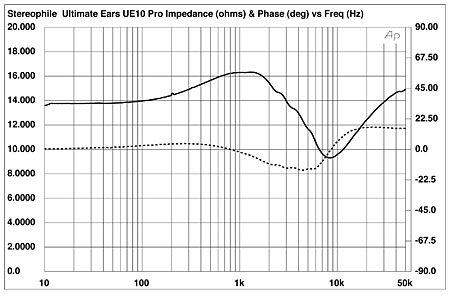| Columns Retired Columns & Blogs |
Ultimate Ears UE-10 Pro in-ear headphones Measurements
Sidebar 2: Measurements
As I've written before, I don't have any means of assessing the frequency response of headphones. However, I did measure the electrical impedance of the UE-10 Pros with my review samples inserted in my ears to provide the correct acoustic loading. The results are shown in fig.1. The impedance magnitude is significantly lower than that of the less-expensive UE-5 'phones, which I reviewed in December 2004, with an average low-frequency value of 13 ohms rather than 22 ohms. In addition, the upper-midrange rise in impedance reaches 16 ohms rather than the UE-5s' 42 ohms. The dip to 9 ohms at 9kHz is similar, however.

Fig.1 Ultimate Ears UE-10 Pro, electrical impedance (solid) and phase (dashed). (2 ohms/vertical div.)
The UE-10s' high sensitivity makes it unlikely that typical portable players will have a problem driving them, but the low impedance at low frequencies will give a lean-sounding bass with, for example, earlier iPods, which had a rising source impedance below 100Hz due to the physically limited size of the output coupling capacitor. I understand that this will not be an issue with the iPod Shuffle and iPod Nano, but I did find that the UE-10 Pros' bass performance with my 2003-model iPod benefited from the use of a Ray Samuels Audio Emmeline Hornet headphone amp.—John Atkinson
- Log in or register to post comments




































